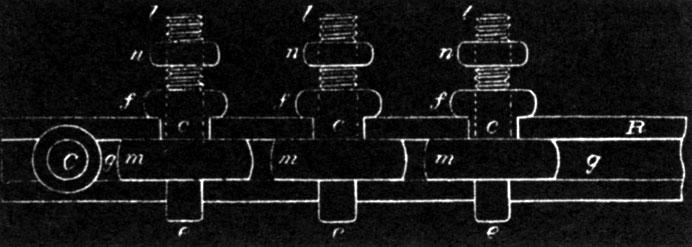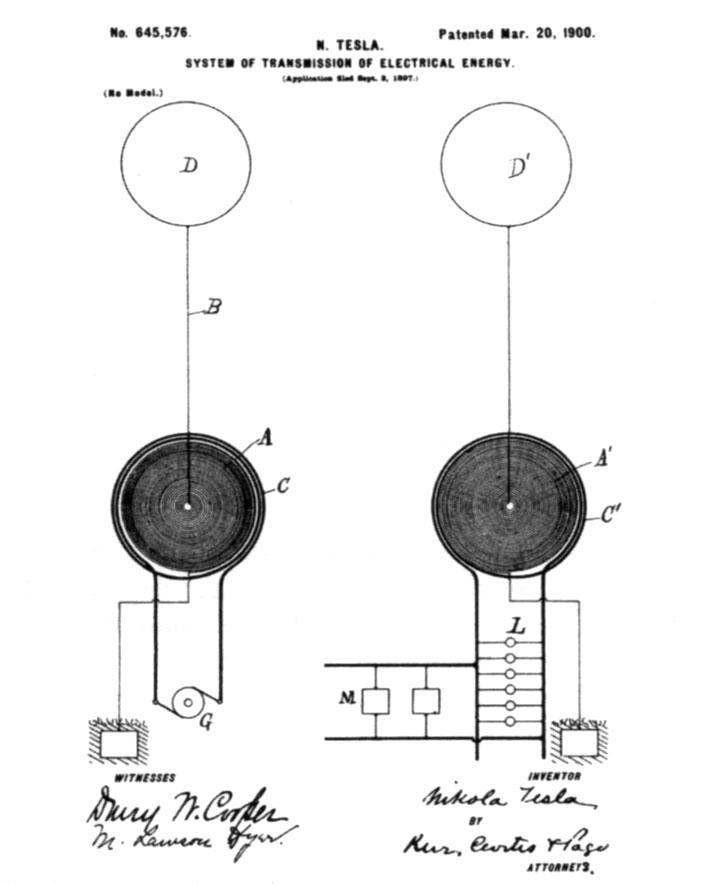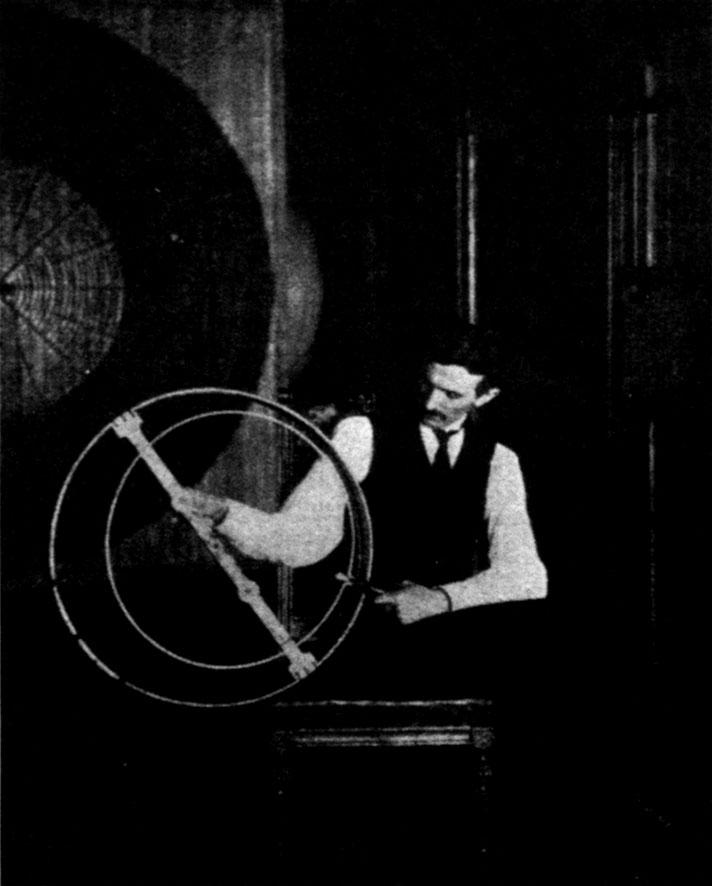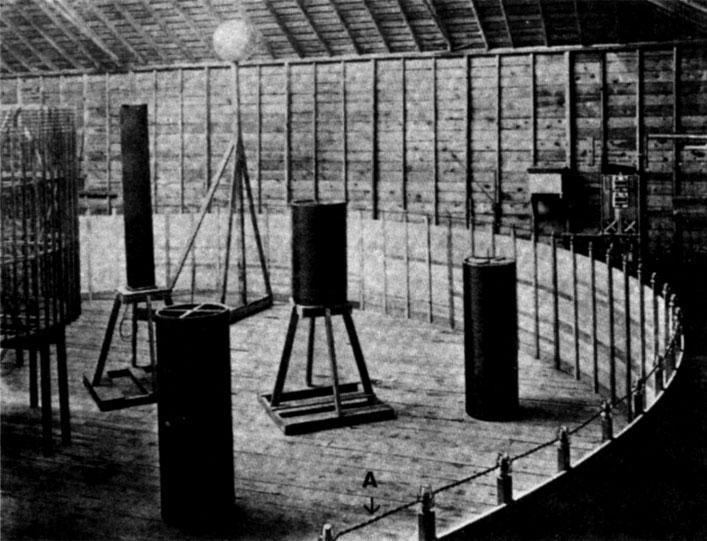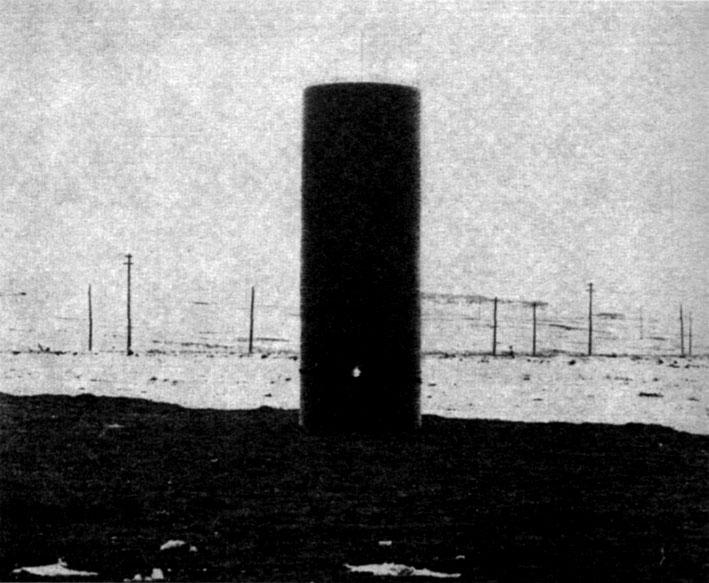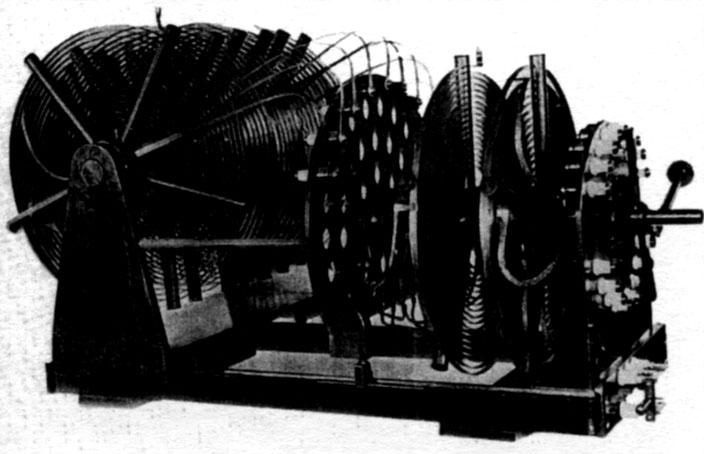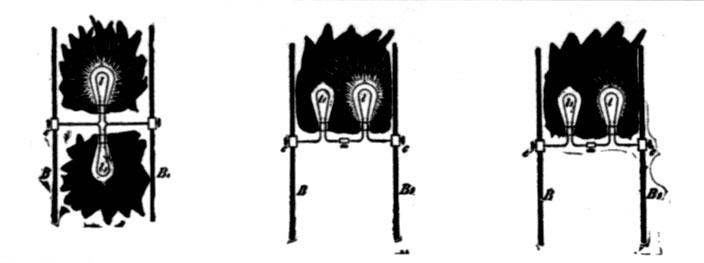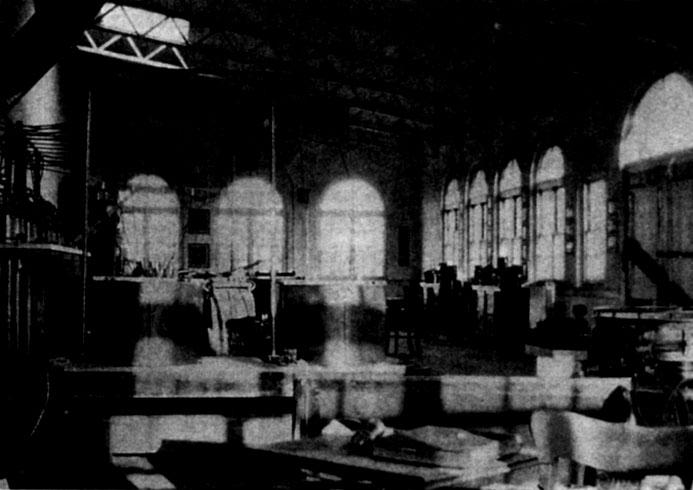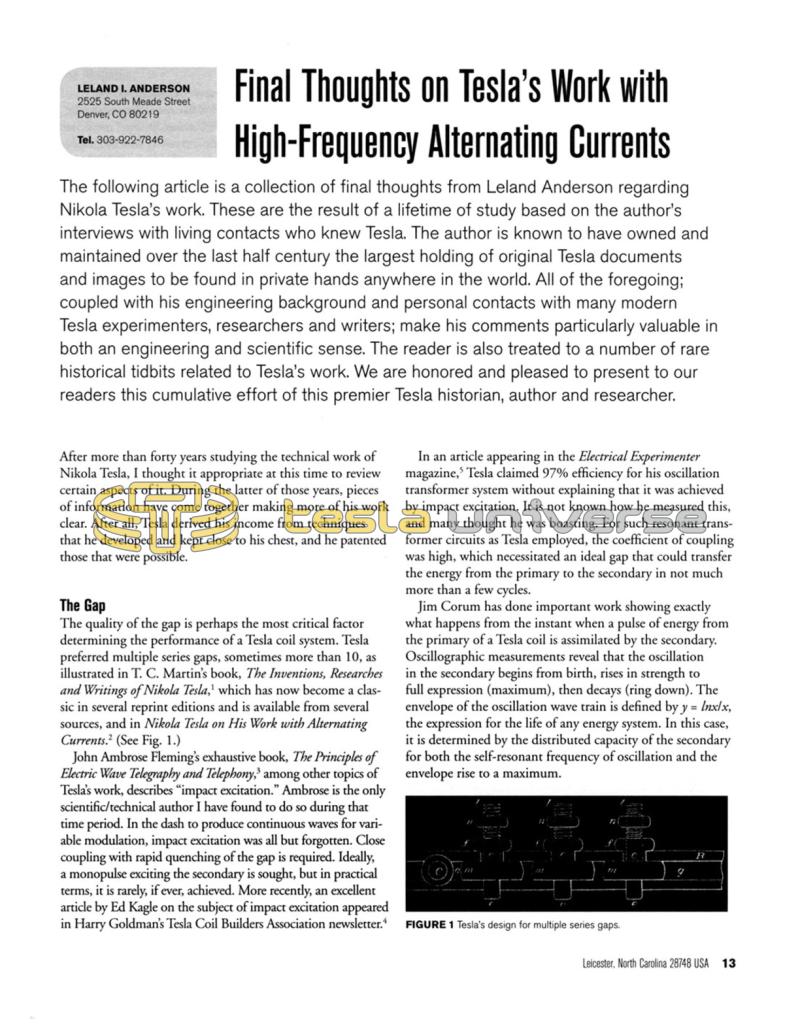
Nikola Tesla Articles
Final Thoughts on Tesla's Work with High-Frequency Alternating Currents
The following article is a collection of final thoughts from Leland Anderson regarding Nikola Tesla's work. These are the result of a lifetime of study based on the author's interviews with living contacts who knew Tesla. The author is known to have owned and maintained over the last half century the largest holding of original Tesla documents and images to be found in private hands anywhere in the world. All of the foregoing; coupled with his engineering background and personal contacts with many modern Tesla experimenters, researchers and writers; make his comments particularly valuable in both an engineering and scientific sense. The reader is also treated to a number of rare historical tidbits related to Tesla's work. We are honored and pleased to present to our readers this cumulative effort of this premier Tesla historian, author and researcher.
After more than forty years studying the technical work of Nikola Tesla, I thought it appropriate at this time to review certain aspects of it. During the latter of those years, pieces of information have come together making more of his work clear. After all, Tesla derived his income from techniques that he developed and kept close to his chest, and he patented those that were possible.
The Gap
The quality of the gap is perhaps the most critical factor determining the performance of a Tesla coil system. Tesla preferred multiple series gaps, sometimes more than 10, as illustrated in T. C. Martin's book, The Inventions, Researches and Writings of Nikola Tesla,1 which has now become a classic in several reprint editions and is available from several sources, and in Nikola Tesla on His Work with Alternating Currents.2 (Sec Fig. 1.)
John Ambrose Fleming's exhaustive book, The Principles of Electric Wave Telegraphy and Telephony,3 among other topics of Tesla's work, describes “impact excitation.” Ambrose is the only scientific/technical author I have found to do so during that time period. In the dash to produce continuous waves for variable modulation, impact excitation was all but forgotten. Close coupling with rapid quenching of the gap is required. Ideally, a monopulse exciting the secondary is sought, but in practical terms, it is rarely, if ever, achieved. More recently, an excellent article by Ed Kagle on the subject of impact excitation appeared in Harry Goldman's Tesla Coil Builders Association newsletter.4
In an article appearing in the Electrical Experimenter magazine,5 Tesla claimed 97% efficiency for his oscillation transformer system without explaining that it was achieved by impact excitation. It is not known how he measured this, and many thought he was boasting. For such resonant transformer circuits as Tesla employed, the coefficient of coupling was high, which necessitated an ideal gap that could transfer the energy from the primary to the secondary in not much more than a few cycles.
Jim Corum has done important work showing exactly what happens from the instant when a pulse of energy from the primary of a Tesla coil is assimilated by the secondary. Oscillographic measurements reveal that the oscillation in the secondary begins from birth, rises in strength to full expression (maximum), then decays (ring down). The envelope of the oscillation wave train is defined by y = lnx/x, the expression for the life of any energy system. In this case, it is determined by the distributed capacity of the secondary for both the self-resonant frequency of oscillation and the envelope rise to a maximum.
The Condenser in the Primary Circuit
The condenser may seem simple enough as long as it can withstand the excitation voltage plus the resonant voltage rise in the primary circuit. At his experimental station in Colorado Springs, Tesla took the construction of his condenser banks to a higher refinement level. As most will recall from his earlier writings, air bubbles in high-frequency, high-voltage equipment must be completely avoided. The condenser banks at his experimental station consisted of tanks filled with brine and empty mineral water bottles set in the tanks with brine inside. Thus, the conducting brine solution was in intimate contact with the dielectric surface of the bottles.
These bottles were not the common types one finds today. Most common bottles have a green cast, indicating iron in the glass, but Tesla used bottles with potash content glass, clear and having no color cast, that he obtained from the famed mineral water springs dealers in Manitou Springs, misspelled as Maniton Springs in Tesla's Colorado Springs Notes.6 Manitou Springs is a small town west of Colorado Springs on the way to Pike's Peak. Whenever visiting the town, I would check with various antique dealers to see if they had one of these bottles. This is something I wouldn't attempt to do by phone, because I question the ability of the average antique dealer to know the difference between bottles. I wanted to put one up on a shelf and look at it for inspiration. I was not in luck. Iron content glass bottles were used later on, being lower in cost.
At the time Tesla was in Colorado Springs, it had become known as a haven for consumptives who could afford it, being 700 feet higher than mile-high Denver with an excellent climate. The city derived considerable revenue from these residents. One day, Tesla mentioned to a city father, “I find there are two kinds of people in Colorado Springs.”
“Oh?”
“Yes. Those who have consumption and those who want to get it.” Tesla recorded that he was almost thrown out.7
The Coils System
Tesla reached what he believed was the apotheosis of contemporary coil design with his flat spiral secondary. It was illustrated in the New York Electrical Review,8 unexcited and without explanation, and most recently in a biographical article by Bernie Carlson in Scientific American.9 The coil, which was eight feet in diameter, can be seen in the background of Fig. 2.
While undertaking university studies, I constructed a spiral coil. The winding was set in slots of a spoked wheel frame six feet in diameter. Visitors said it looked like a giant spider web. I haven't known of anyone else who has constructed such a coil, but I found it had some interesting properties. One day, when the coil was weakly excited, I walked by it, and a three-foot spark leaped out and hit my arm. For a fraction of a millisecond, I guess, I thought I was a goner.
When the coil was unexcited, a wave meter on the coil showed significant changes in the self-resonant frequency as large metallic objects nearby were moved. This is because the distributed capacity for the spiral coil is appreciably less than it is for cylindrically wound coils and can be capacitively loaded while operating at a quarter wavelength. Tesla always showed a spiral coil loaded with a balloon capacitor tethered by a conductor in patent drawings from that time on. (See Fig. 3.)
The Magnifier
To reduce the capacity effect of nearby objects, I placed a grounded vertical pipe in front of the coil. It is surmised that Tesla, experimenting daily, by chance placed a closely-wound coil in a horizontal plane (no mutual coupling) in front of the spiral coil as a stabilizing target. A great “efflunge” in the discharges resulted. By that chance action, the magnifier principle was discovered. No logical progression in circuit development would have led to it. The NY Electrical Review for October 26, 1898 carried an 11" x 17" photograph supplement illustration showing the coil in action.10 (See Fig. 2.) The term “magnifier” was not used at that time.
Richard Hull has perhaps engaged in more experimental work with magnifier coils than anyone, and he has written extensively about it.11 His Tesla coil driver and the magnifier coil were much smaller than Tesla's in Colorado Springs, but Hull achieved nearly equal and possibly equal length discharges. All readers who have a copy of Tesla's Colorado Springs Notes should also have a companion volume of Hull's extensive analysis of them, which carries a section on magnifiers.
What sort of electrical component is the magnifier? What causes it to do what it does? This would be an interesting topic for an electrical engineering student's Ph.D. candidate dissertation.
Statics
Tesla mentioned in advanced writings that in the late 1890s he was bothered by unwanted signals received at operational frequencies. His term for the phenomenon was “statics.” To overcome this problem, he conceived the idea of what is now called the AND logic gate, the conjoint reception of two or more simultaneous signals necessary for a valid reception.
Two months before leaving for Colorado Springs to establish an experimental station, Tesla called in the Electrical Review publication to take some photographs in his laboratory on Houston Street. The journal then published over ten good quality photographs of Tesla conducting experiments in their March 29, 1899 issue.12 Photographs of an inventor or scientist actually engaged in work were exceedingly rare.
The frontispiece of Tesla: Guided Weapons & Computer Technology shows one of the photographs, but a different one is described by the caption.13 (See Fig. 4.) This should be corrected in the next edition. Obviously, one of the two coils shown on the cylindrical form is not comprised of 300 turns. The correct photograph, as described in the text, shows Tesla holding a similar cylindrical coil form combination with an open-ended aluminum turn set apart from the outermost turn of the coils. What is not mentioned, and this is one of Tesla's secret techniques, is that this turn is folded back, or reversed, so as to suppress the potential gradient at the high-energy end of the coil. Many Tesla coil constructors have been bothered by brush discharge at the top of a vertical coil, before the top winding is brought to a terminal. This technique should help. In the photographs shown of Tesla's coil in Colorado Springs, this suppression turn can be seen mounted on telephone pole insulators.14 (See Fig. 5.)
Getting back to the visit by the Electrical Review people to Tesla's Houston Street laboratory, Tesla was experimenting with the conjoint operation of two coils lighting a lamp, but he did not mention this to them. This was a secret. All they saw were methods of producing wonderful electrical discharges.
Tesla at Colorado Springs
Tesla went to Colorado Springs for two prime reasons:
1. To establish that what we now call AND logic gates work not only by induction but also by electromagnetic wave transmission (undisclosed).
2. To get away from New York City and explore methods of handling high-potential currents of high frequency and high power, unrestrained by walls and ceilings, as he was at his Houston Street laboratory (announced).
Much has been analyzed and written about the second reason by Jim Corum, Richard Hull and others, and I have little of significance to add. The discussion that follows concerns the first reason.
When I was first studying the work of Tesla, I purchased a copy of the Century book-magazine for June 1900, which carried his philosophical article, “The Problem of Increasing Human Energy.”15 This article is noted for being the first to be published with fine-screen photographs, which other presses were incapable of producing. The photographs, illustrating Tesla's work at Colorado Springs, have been reproduced in many publications since.
As I was beginning my study of Tesla's work, I was puzzled by one photograph of a cylindrical vertical coil form standing in a field with a tiny lamp glowing part-way along the coil16 (See Fig. 6.) and wondered why Tesla expressed enthusiasm for it with other photographs showing great electrical discharges. This all became clear later on when his invention of what we now call the AND logic gate was brought to my attention by a patent attorney for a computer corporation. The claims for that patent were so tightly-written that no one since has been able to show any improvement in the invention. Incidentally, the intricate cover design for that issue of the Century was executed by famed architect Stanford White, who designed Tesla's laboratory building at Wardenclyffe.17
The photograph described above is also illustrated in Nikola Tesla on His Work with Alternating Currents,18 accompanied by a full-paragraph description which unfortunately is vaguely worded. This is strange, inasmuch as Tesla had been granted the patent for the invention soon to expire. But times changed. Tesla found it more lucrative, as he once wrote, to discover other parties using his inventions and sue for infringement than to license his ideas for royalties.
One day, George Scherff wrote to Tesla from his office on Houston Street that a letter was received from Lee de Forest asking if it would be possible for Tesla to hire him as an assistant. Tesla asked that a reply be sent saying he would not be able to take him on at that time. Tesla had another assistant in Colorado Springs, and he was Fritz Lowenstein. A man who had been hired as a young lad by Tesla to clean the station each day; wind, unwind and rewind coils; and do other tasks wrote that Fritz had bright red hair. This is something one won't find in any thumbnail bio sketch of Lowenstein.
In the 1910s, Lowenstein established a radio company and sold transceivers, carrying nameplates of the Tesla patents involved, to the US Navy. The Secretary of the US Navy, Josephus Daniels, wrote that these were the best transceivers they had used. A photograph of one of these transceivers is shown in Nikola Tesla on His Work with Alternating Currents.19 (See Fig. 7.) After WWI, the Marconi Company sued, claiming the US government used transceivers infringing on Marconi's patent. The US government used Tesla's patents as a defense and won, but the case worked its way through the appellate courts for several years before it was decided, ten months after Tesla's passing. As Tesla once wrote, “My priority will be shown by the records.”20
In looking at the two identical condenser banks of the excitation apparatus used at Colorado Springs, someone mentioned to me that Tesla must have admired symmetry in all things. Well, it is designed that way for a technical reason. When Tesla was testing his AND logic gate invention by transmission, one condenser bank tuned the primary to one frequency and the other tuned it to another frequency. The two tunings were rapidly interchanged, so that during simultaneous ring-down, they overlapped and two different frequencies were transmitted. Of course, no streamers were used.
Standing (Stationary) Waves
One of the most brilliant lecture demonstrations illustrating standing waves was performed in Tesla's lectures of 1893. The apparatus is shown in T. C. Martin's book.21 (See Fig. 8.) It consists of large copper rods configured like a giant hairpin with 50 and 100 volt bulbs connected across the copper arms at various places. The actual size of the apparatus is not described in the accompanying text, but judging from a photograph, they stand about three feet high.
These apparatus demonstrate what today we call a transmission line, shorted at the termination. Many in the audience of this lecture must have thought Tesla was performing some kind of magic with the bulbs lit at carefully designated places. Anyone acquainted with the art can calculate the approximate frequency used which was extremely high. What surprises me is the power and stability of the excitation frequency. It reminds me of a remark made by George C. Clark, who was Tesla's assistant for his 1891 lecture at Columbia College. At the conclusion of one demonstration, George started to shut down the alternator, and Tesla shouted, “Keep it running or the lack of ventilation will destroy it!” Tesla always pushed apparatus to their limit.22
When in Colorado Springs, Tesla interpreted measurements of the electrical signals from lightning as oscillations set up in the earth producing standing waves. Tesla wrote about it and described it in a patent.23 But according to the findings of an analysis performed by the Wave Propagation Laboratory of the US Department of Commerce National Bureau of Standards at Boulder, Colorado, what Tesla actually observed was reinforcement and cancellation of re-radiation off the nearby mountain range as the storm traveled.24
Tesla thought he had made a remarkable discovery supporting his dream of transmitting electrical energy without wires. He undoubtedly remembered very well his demonstration of a “no wire motor” in the 1892 lectures25 and drew an erroneous conclusion from it. Tesla's patents on this subject concern the wireless transmission of energy. He was correct in his ideas on the subject. But on his concept of oscillating the earth's static charge, he didn't see what every ham radio or radio transmission engineer now knows, that a high VSWR means little power is reaching the antenna. Little was known about these principles at the time.
Return to New York City
When Tesla returned to New York in early January 1900, he was very busy: preparing the patent application for his AND logic gate invention, writing the long article for the Century for publicity purposes without mentioning the preceding, securing land on Long Island where he wanted to build a power plant demonstrating his energy transmission idea, and raising an extraordinary sum of money to construct it. The inducement was to outperform the transatlantic cable.
Before the power plant and tower were completed, Tesla ran a preliminary test, which failed. They never would have worked, being built on a false premise. Tesla tried to interest J. P. Morgan in financing a new plant, but no additional funds were forthcoming. Tesla was broke. He mortgaged the Wardenclyffe property twice to pay rent at the Waldorf Astoria. Intending to return to the Colorado Springs experimental station in 1905, he had hired a watchman to keep an eye on the place. Not keeping up on the payments, he was sued; and he paid the settlement off in paltry amounts over a few years showing his irritation over the matter. The City of Colorado Sptings seized the property for nonpayment of taxes and ordered it dismantled for sale of the lumber. I had hoped that the plank above the doorway carrying an engraving of the well-known line from Dante's Inferno (in Italian, of course), “All ye who enter do so at your own peril,” might have been saved, but after a century, it hasn't shown up.
In the midst of all this, Tesla was forced to travel to Federal District Court in Seattle to defend his radio patent against a challenge. He brought several pieces of apparatus with him for demonstration and left them there as case exhibits. He had to do something to raise money, and in 1904 he announced his entry into the field of consulting engineering. The announcement was in the form of an oversize folder on vellum. The outside page carried a faint photograph of his magnifying transmitter tinted in green with an overwrite of his principles; the second page, a list of his major accomplishments; and the third page, a list of all his patents.
The announcements were sent out to financiers and captains of industry with a special letter to each stating what Tesla might be able to do for them. The envelopes carried a red wax seal on the flap with Tesla's initialed insignia. For years I asked autograph dealers to look for one of these, and some years ago, two were offered to me.
Tesla did not return to Wardenclyffe. It remained unwatched and dark. After awhile, looting and pillaging began. The ransacking was eventually complete. The museum cases filled with apparatus and anything that could be moved were taken. I'm not sure what this says about our society. The Smithsonian Institution has been constantly looking for at least one piece of Tesla's apparatus, but nothing has shown up.
Before the looting began, Long Island historian Tom Bayles took a photograph through a window of the Wardenclyffe laboratory in its last state of development. It is the best photograph that has been taken and appears as the final illustration in Guided Weapons & Computer Technology.26 (See Fig. 9.) The narrative beneath the illustration should be replaced by a caption identifying principal items in the photograph. I will identify two. One of Tesla's radio-controlled boats is directly behind the chair at the design table. It appears to be more than seven feet long. This is the only photograph of it showing size, as all previously published photographs showed no other objects for scale. Tesla's spiral coil is shown hanging from the rafters with a very large cable leading to a magnifier coil some distance away, also hanging from the rafters. I believe this cable is fashioned after Tesla's patent 514,167, but we may never know how effective it was. Those who have constructed magnifier coils have noticed that leakage can occur when the magnifier coil is an appreciable distance from the Tesla coil driver.
Tesla's entrance into the field of consulting engineering paid off. In a few years he was able to open offices across the street from the New York Public Library, hiring three secretaries. He soon dismissed one for being overweight and clumsy. I knew the other two secretaries, Dorothy Skerritt and Muriel Arbus. Whenever traveling to New York City, I would take them out to dinner. They ran out of things to say about Tesla after the first two visits, so from then on we talked about things of mutual interest.
Dorothy's job consisted of handling legal and patent correspondence and going across the street to the library to copy articles in shorthand and retype them for Tesla. There were no copy machines then. Muriel's job was to handle all other correspondence and prepare articles for publication. I was most interested in remarks she made about some of Tesla's visitors. After WWIl she started a business selling machine tools disposed of by the War Assets Administration and was quite successful at it. She was the only woman in the business.
Getting back to the Wardenclyffe property, the Waldorf Astoria owners foreclosed on the mortgaged property, but not before the case went before the Stare of New York Supreme Court. The Waldorf Astoria owners could see that the property had little resale value with that big tower standing on it and ordered it destroyed. Some writers imagined that the tower was destroyed by the US government to prevent its use by German spies as an antenna, but the records show differently.
Afterword
Because of failing eyesight, this is the final writing I will undertake about Tesla and his work. It's been an exciting trip. My large archive on Tesla has been acquired by the John Heinz Research Center in Pittsburgh with three more units to join it soon.
Notes
- T. C. Martin, The Inventions, Researches and Writings of Nikola Tesla, 2nd ed., (New York: The Electrical Engineer, 1894; reprint, New York: Barnes & Noble, 1995), 211 (page citation is to the reprint edition).
- L. I. Anderson, ed., Nikola Tesla on His Work with Alternating Currents and Their Application to Wireless Telegraphy, Telephony, and Transmission of Power, (Denver, CO: Sun Publishing, 1992; reprint, Breckenridge, CO: Twenty First Century Books, 1998-2006), 50 (page citation is to reprint edition).
- J. A. Fleming, The Principles of Electric Wave Telegraphy and Telephony (New York: Longmans, Green & Company, 1906).
- E. Kagle in newsletter of the Tesla Coil Builders Association Oct/Nov/Dec 1991.
- Efficiencies as high as 85% were reported in N. Tesla, “Electrical Oscillators,” The Electrical Experimenter (July 1919), reprinted in <www.tfcbooks.com/tesla/1919-07-00.htm>. Tesla claimed he could transmit power through space with 97% efficiency in “Minutes of the Annual Meeting of the American Institute of Electrical Engineers,” New York, NY (May 18, 1917), reprinted in J. T. Ratzlaff, ed., Tesla Said (Millbrae, CA: Tesla Book Company, 1984), 188.
- See, for example, N. Tesla, Colorado Springs Notes: 1899-1900, A. Marincic, ed., (Beograd, Yugoslavia: Nolit 1978), 118.
- Tesla states this observation with no reference to the city fathers in N. Tesla, Colorado Springs Notes: 1899-1900, 132.
- N. Tesla, “Tesla's Achievements in Vacuum Tube Lightning,” Electrical Review New York (May 20, 1896): 262-263.
- B. Carlson, “Inventor of Dreams,” Scientific American (March 2005): 78.
- N. Tesla, “Tesla's System of Electric Power Transmission through Natural Media,” Electrical Review New York (October, 26, 1898): 257-258.
- R. Hull, The Tesla Coil Builders Guide to the Colorado Springs Notes of Nikola Tesla (Richmond, VA: Richard Hull/Tesla Coil Builders of Richmond, 1993).
- N. Tesla, “Some Experiments in Tesla's Laboratory with Currents of High Potential and High Frequency,” Electrical Review New York (March 29, 1899): 195 ff.
- L. I. Anderson, ed, Nikola Tesla: Guided Weapons & Computer Technology, (Breckenridge, CO: Twenty First Century Books, 1998). ii.
- N. Tesla, Colorado Springs Notes: 1899-1900, 323.
- N. Tesla, “The Problem of Increasing Human Energy.” Century (June 1900): 175-211.
- Tesla, Colorado Springs Notes, 352.
- I thank architect Christopher Bach for this bit of artistic history.
- Anderson, Nikola Tesla On His Work, 96.
- Ibid., 183.
- Tesla wrote several letters to editors of publications in defense of his priority. Anderson reproduced a pre-hearing inteview with Tesla, conducted for Marconi Wireless Telegraph Company of America v. Atlantic Communications Company, et al., in Nikola Tesla on his Work.
- Martin, The Inventions, Researches and Writings, 351.
- This interchange is not documented in commonly available literature. In Anderson, Nikola Tesla on his Work, p. 6, Tesla states, “I remember that at Columbia College, Mr. [Gano] Dunn, who is now vice-president of the White Company, I believe, and who was assisting me in the lecture, forgot to turn off the current in the field when the machine was stopped, and if I had not shut it off, the field would have burned out.”
- Nikola Tesla, “Art of Transmitting Electrical Energy through the Natural Mediums,” US Patent 787,412, filed May 16, 1900, issued April 18, 1905.
- Report from the Wave Propagation Laboratory of the US Department of Commerce National Bureau of Standards, reprinted in L. I. Anderson, Nikola Tesla's Concepts for Transmission of Electrical Energy without Wires (Denver, CO: Leland Anderson, 1999), Appendix.
- Martin, The Inventions, Researches and Writings, 234.
- Anderson, Nikola Tesla: Guided Weapons, 233.
